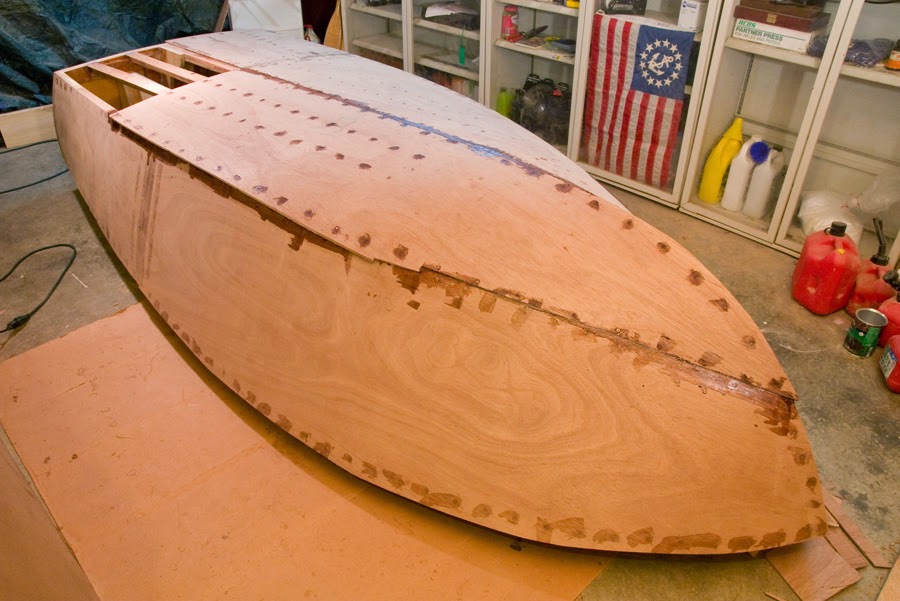I have decided to paint the exterior as the hull is upside down and ready at this point. Centerboard will get painted as well.
The paint du jour is System III waterbased linear polyurethane. The plan is to give the hull 2-3 coats of primer then lightly sand til smooth and then attempt a roll and brush tip approach with the top coat. This paint will clean up with soap and water and has very low VOC for use in close areas without ventilation. This is important in that I cannot control the environment in my small garage and need something safe. The downside is that it does not go on well in hot weather, therefore the timing of doing this in October in New England should be good. Although falling leaves and neighbors with leaf blowers can ruin a finish in the blink of an eye.
The whole boat has been sanded to 180 grit and dusted and wiped clean of dust with rags and solvent. I will do it one more time prior to the application of the paint. Photos coming.
10-2-14Two coats of primer were applied today. Amazing how it looks better already. The LPU goes on very thin and needs tipping with a polyester brush. One needs to work pretty quickly. It takes a couple of hours for one coat to dry sufficiently to do another coat on top. I did make the mistake of going back over the transom as I thought it was too thin, leaving an orange peel effect. Fixable with more sanding...
Looks like it will be three coats of primer prior to top coat. Sanding with 180 grit prior to the final coat.
A quick word on the waterbased LPU. It rolls on easily, washes off with water, and has little VOCs. This makes it a good paint for the homebuilder working in less than ideal conditions (some moth has taken up permanent residence in the centerboard).
10-3-14
Forgot to put the centerboard in the garage last night before going to work. It rained...
Just read this on the materials sheet.
"The film will not be water-resistant until it is cured. Rain or moisture
from dew or condensation can damage the film. The primer cures as a
relatively rigid film, so is not recommended for use on flexible substrates
like fabric or thermoplastic" Oh dear. looks like more sanding. Again.
Postmortum - It actually had just a little dribble that was easily sanded out. This aspect of the project is going well. Helps to read the directions.
Did a little further shaping of the rudder today and prepped the headstock for paint since that is what we are doing right now. Does not look as if a third coat of primer will be necessary, but I will take the boat out in light tomorrow to sand and double check.
10-4-14
hand sanded with 150 grit this morning for two hours then applied a coat of top coat. the LPU paint is best applied with a sprayer, but I have none, so went with roller and brush. The result is not as smooth as I had hoped. will sand again between coats in an attempt to control the finish product. It can be thinned with a little water and will try that next time as I think the lack of humidity today caused the paint to set up way too fast.
October 6, 2014
put on another two coats this morning and afternoon dodging the rain. The online builders forum suggested painting on a rainy day with the garage door open. Yup, much better results. Then an old buddy of mine suggested that I go to 4 coats and wet sand / buff for a final mirror finish. Yup. Thats the plan. Well see if I have enough paint on.
Fourth coat applied.
 |
The light spot is the reflection from behind! This is working.
Hope to get a photo outdoors tomorrow.
|
Here is a photo after 4 coats taken in good light.
The resulting finish looks ok from 5 feet away, but there are a lot of brush marks that are moderately deep. I have attempted to buff these out using the long board, 400, 600, 800, 1000, 1500, 1800 grits successively. Then, following up with rubbing compound and polish. The result is mixed as I have a lot of halos showing.
 |
| Aft starboard panel has been wet sanded from 400 through 1500 then buffed with rubbing compound and polish. It is a very slick surface that is highly reflective. Many surface swirls however. |
 |
Hmm. looks better now after sanding down the brush marks and polishing polishing polishing. I did wear through one spot that will need touch up, and some scratches got into the coat from some dirt that got under then sandpaper. Ouch. Not visible when the boat is on the trailer, but I know its there! Will touch up today.
|
Found out that I was in possession of a buffer/polisher in that the 7" angled grinder was actually a 6" sander/polisher according to the label on it! Will get a better pad and backing plate and try this in the spring. Boat is now upright and ready to finish as much of the interior prior to the weather closing in.
 |
| Does not look too bad from this far away. Needs polishing and buffing. |
Summary:
If using waterbased LPU applied with Roller/brush
1. 4 coats primer
2. Wet sand with 400 to smooth finish
3. apply 3 coats top coat
4. Buff til smooth and scratch free.
that sums it up and will save someone a ton of time.









































































